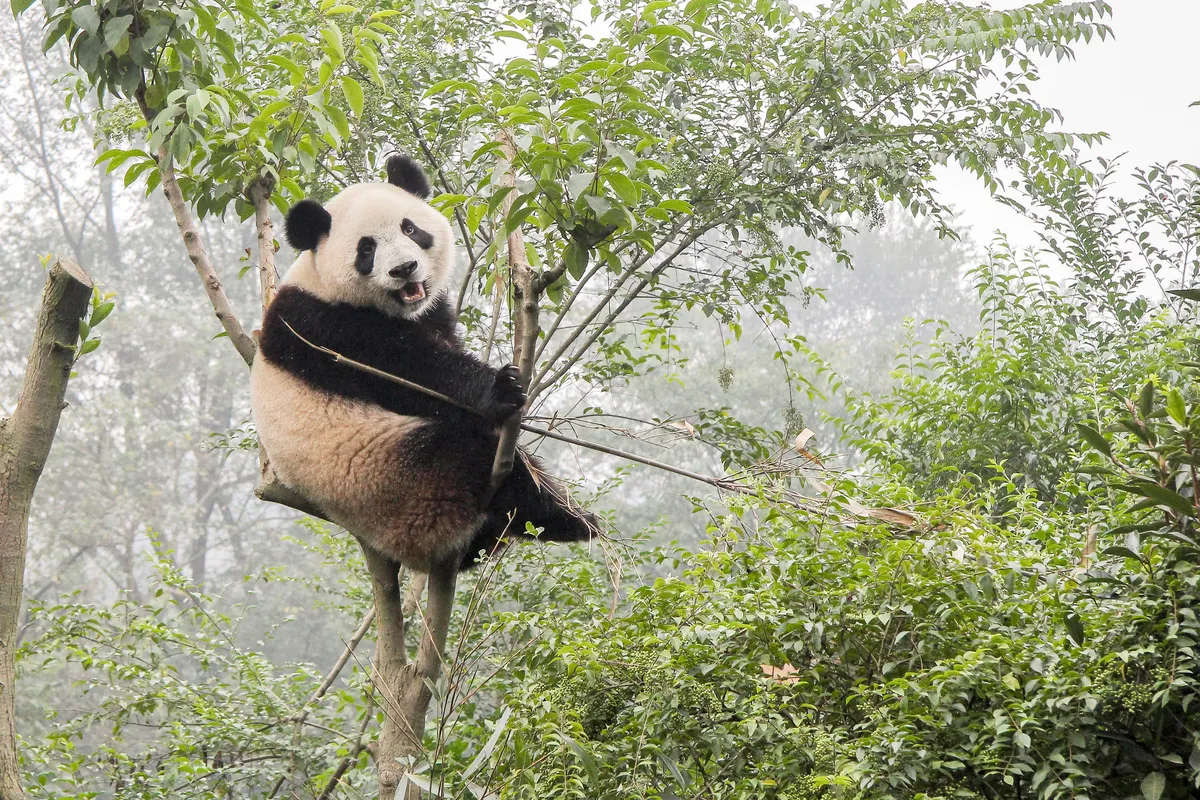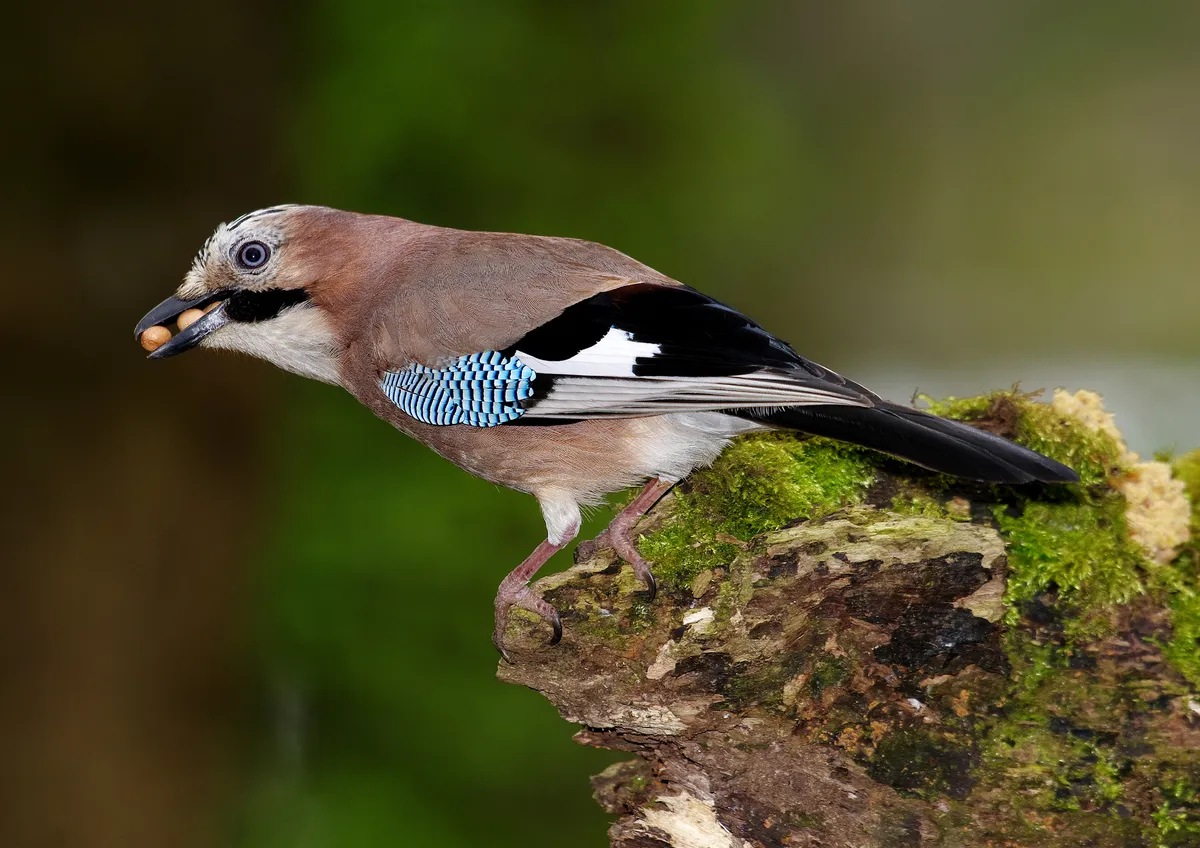Have you ever wondered which animals guzzle down the most food? Some species must eat all the time to survive – leading a whole life ruled by finding their next meal. Others eat their own weight in food – or more! – every day, and others can consume a shocking amount in a single meal.
Greediest animals
Giant pandas (Ailuropoda melanoleuca)

A species of bear that lives in China, almost all of the giant panda’s close relatives are meat-eaters. A few million years ago, giant pandas were too. For some reason that we are still unsure of, they switched to eating bamboo instead of animals.
- Do pandas only eat bamboo?
- It's one of the world's most beloved animals, weighs as much as a a sumo wrestler and has one of the most boring diets on the planet
The problem is, they are pretty poorly adapted to being herbivores. Their guts, and the microbes that live within, are still set up for digesting meat. In fact, their guts are so poorly adapted to getting nutrients from bamboo that they only manage to digest about 17% of the plant.
In order to get the energy they need to survive, pandas must therefore spend a whopping 10 – 16 hours a day (pretty much all their waking hours) eating.
Giant silk moth larvae (Saturniidae family)

The caterpillars of giant silk moths are voracious eaters. And it’s no surprise. They have an energetically costly journey in front of them, and it is one in which they cannot eat.
When giant silk moth caterpillars pupate, their whole body rearranges into their final form – a beautiful, and gigantic, moth. But they cannot eat as a pupa, and when they hatch as adults, they do not have functioning mouthparts and so cannot eat. This means that all the energy required for metamorphosis and adult life is down to the caterpillar to eat.
This is why the giant silk moth larva eats 86,000 times its body weight in plants within its short (often 4 – 8 week) life as a caterpillar. That’s the equivalent of one human eating 750,000 loaves of bread a week!
Eurasian jays (Garrulus glandarius)

The Eurasian jay, a species in the corvid family native to Europe, North Africa and Asia, is excellent at planning for future hunger. Over winter, many of the jay’s favourite foods become scarce, and so it stores food so that it won’t go hungry.
The jay collects acorns and other nuts, and buries them or hides them in trees. Jays will bury thousands of nuts across large areas, and, amazingly, they remember the precise location of most of their buried treasure.
Studies have found that jays probably use ‘mental time travel’ to remember where they’ve buried their food. This means they ‘relive the past’, in much the same way that humans, when trying to remember where we’ve put our keys, imagine the last time we had them – what we were doing, where we were going – so that we can track down their location.
But jays are even better than humans when it comes to remembering the location of objects. Imagine burying 1000 sets of keys across many miles of land, and having to remember – months later and without a map – where each was buried. I don’t know about you, but I’d be lucky if I could remember ten locations, let alone 1000.
Spotted hyenas (Crocuta crocuta)

One of Africa’s top predators, the spotted hyena is not a fussy eater. They will hunt prey – sometimes as large as hippos – but they will also steal food off other predators, and even eat rotting carcasses. Pretty much any meat is on the menu for a hyena, even if it’s stinky.
- Could a hyena take on a lion? Nail-biting video shows close and fiercely-fought battle between these carnivorous predators
- "My first reaction was disbelief": spotted hyena seen in Egypt for first time in 5,000 years
Not only are hyenas pretty blasé about the source of their food, they will also eat every single part of the meal. Yep, that means bones and all – with specialised teeth, hyenas can chew bones into bite-sized pieces. Once a pack of hyenas has finished its meal, there is often nothing left.
Hyenas are also able to eat a shocking amount in a single meal. In one sitting, they can eat 15kg – a third of their body weight!
Blue whales (Balaenoptera musculus)

Blue whales – which inhabit all oceans except the Arctic – are the biggest animals in the world. They can grow up to 30 metres long and weigh a whopping 200 tones.
Perhaps unsurprisingly, the biggest animal in the world needs a lot of food to survive. But, surprisingly, the blue whale’s diet consists of a teeny-tiny creature.
Krill, a type of shrimp-like crustacean, are typically just a few centimetres long, but they swim in groups that can number in the billions. By scooping krill up into their humungous mouths, blue whales can swallow millions of krill in a single swallow, equating to half a million calories in one gulp. In a single day, blue whales can eat four tons of krill – the equivalent of an elephant.
American pygmy shrews (Sorex hoyi)

From the world’s biggest animals to one of the world’s smallest mammals, the American pygmy shrew is about 5cm long and weighs just a few grams. Despite being so small, these rodents have gigantic appetites. This is because of their extremely high metabolisms, which work hard to keep the shrews’ little bodies warm and their hearts beating around 1000 times per minute (or 17 beats per second).
To fuel their hard-working little bodies, American pygmy shrews must eat every 15 to 30 minutes, day and night. This means they only sleep in short bursts, before waking again to hunt for food.
They typically eat insects, spiders, and woodlice, and if they do not manage to find a meal within one hour, they might die. Their lives are therefore dictated by finding their next meal.
So, if you ever see a shrew out and about, don’t get in its way – even a few minutes of disturbance may well be the line between life and death for these little critters.
Hummingbirds (Trochilidae)

Native to the Americas, there are nearly 400 species of hummingbird. Some are even smaller than the American pygmy shrew, weighing less than 2 grams, while others weigh up to 24 grams.
While American pygmy shrews have incredibly high metabolisms, hummingbirds have the highest metabolisms of any warm-blooded animal. It is so high because hummingbirds must produce the energy required to beat their wings up to 80 times per second while they feast on nectar.
Of course, such a high metabolism requires a lot of calories, and hummingbirds can eat up to the entirety of their own body weight in a single day.
Unlike the American pygmy shrew, who can only snatch sleep here and there between meals, hummingbirds enter a state called ‘torpor’ (similar to hibernation) when they sleep. This slows their metabolism right down, and means they can have a proper night’s sleep without the risk of starvation.
Fleas (Siphonaptera)

Female fleas need blood in order to lay viable eggs, and they lay a whole lot of eggs. This means they are constantly seeking blood, and they can consume up to 15 times their own body weight of blood in a single day.
Using their specially adapted mouthparts, fleas pierce the skin of their host (which can be a mammal or a bird), and then suck up the blood with a tube-like structure that essentially acts as a straw. They also inject an anticoagulant through their saliva, which stops the blood from clotting and keeps that tasty blood flowing into the flea’s body.
Animals with flea infestations can quickly develop anaemia – meaning they are not getting enough oxygen – because the fleas are sucking up so much of their blood. Perhaps not surprising if each female flea is drinking 15 times its body weight per day, and then adding even more fleas to the host’s load as she lays her eggs!
Locusts (Acrididae)

Locusts are grasshoppers that have switched into a ‘swarming’ phase, where instead of living solitary lives, the insects are driven to live in groups. This switch is often triggered when grasshoppers feel overcrowded.
Locust swarms have caused huge problems throughout human history. This is because locusts eat human crop plants, and when they swarm, they can eat so many crops that it can trigger famine.
It’s hard to visualise just how much food a locust swarm can get through. Each individual can eat its own weight in food every day, and large swarms (billions, sometimes even trillions of insects) can devour enough food in a day to feed 81 million people.
- Grasshoppers vs crickets: what's the difference between these two jumping insects?
- If all Earth's insects suddenly disappeared, here's what would happen
Humans (Homo sapiens)
While many animals eat an astonishing amount of food, almost all wild animals eat just enough to survive – or if they eat more than they need in one season, it is often so that they can survive when times get tough in the future. So, can they really be called greedy?
Meanwhile, because of the sheer number of us, around half of the world’s habitable land is dedicated to feeding humans, or feeding the livestock that feeds us. All things considered, then, perhaps humans are the world’s number one greediest animal.
More amazing wildlife stories from around the world
- A 'shark-like' animal is lurking in this US river. And scientists say it's breeding
- Gigantic insect as long as a cat found in Australia. It may be the country's heaviest ever, say experts
- "It's astonishing": animal in India sings when sun is precisely 3.8° below horizon every dawn, say scientists
- Sierra Leone’s wildlife paradise among 26 new UNESCO World Heritage Sites
Top image: giant panda eating bamboo. Credit: Getty





